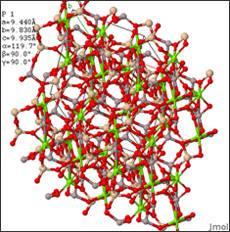Historically, the properties of any new material have had to be determined empirically. It can take many years to transition a material from discovery to a commercial product, which is too slow, given the range of urgent problems that advanced materials can help us solve.
A groundbreaking new tool called the Materials Project uses supercomputers to predict the properties of inorganic compounds that do not yet exist. This tool lets researchers and engineers characterize many properties of each compound. The results are organized into a searchable database. The data lets researchers evaluate the compounds and quickly determine the more promising avenues of research and development to follow.
The time frame for materials to move from discovery to market is lengthy; 10 to 20 years is not unusual. This is mainly due to the continued dependence on scientific intuition and empirical experimentation in materials research & development programs. For example, it can take months of work consulting data tables, performing calculations, and carrying out lab tests to create a simple phase diagram showing the temperatures and pressures at which a complex compound would be solid, liquid, or gas. Furthermore, even when materials have already been studied and the information exists, the results are often scattered across many discrete databases, and therefore, impossible to find.
The Materials Project originated from the Materials Genome Project started in 2006 by Dr. Gerbrand Ceder, the R.P. Simmons Professor of Materials Science and Engineering at Massachusetts Institute of Technology (MIT). The goal was to use computational modeling to design and investigate new materials by mapping the relationship between material's structures and their physical and chemical properties.
Information, such as the phase diagram, can now be generated in a matter of minutes. It is possible to predict a material's properties theoretically before it has even been manufactured, greatly reducing the time spent on testing and development. The site's tools can quickly predict how two compounds will react with one another, what that composite's molecular structure will be, and how stable it would be at different temperatures and pressures.
With the help of supercomputers at the Department of Energy's National Energy Research Scientific Computing Center (NERSC), the Berkeley Lab, and systems at the University of Kentucky, the Materials Project database currently forms a central repository that contains the structural and energetic properties of almost 19,000 inorganic compounds with more added daily.
Already scientists are using the tool to work with companies interested in making stronger, corrosion-resistant lightweight aluminum alloys, which could make it possible to produce lighter weight vehicles and airplanes. The tool has been successfully used for the prediction and discovery of materials used for clean energy technologies, including lithium ion batteries, hydrogen storage, thermoelectrics, fuel cell electrodes, and photovoltaics.
Cedar also suggests that the tool could offer improvements in technical education. When professors set up experiments to help students learn specific principles, they had to pick easy examples with known outcomes. Now, it's possible to set much more challenging theoretical exercises.
The web-based search application lets users search for information on specific chemical formulas or to customize their searches by chemistry, composition, or property. The below image shows part of the result of one of these searches.

The Materials Project is available for use by anyone, although users must register in order to spend more than a few minutes, or to use the most advanced features.
The importance of fast and accurate development of new materials is underscored by the inclusion in the Federal FY12 budget of $100 million to launch the Materials Genome Initiative, with funding for the Department of Energy, the Department of Defense, the National Science Foundation, and the National Institute of Standards and Technology. The initiative will fund computational tools, software, new methods for material characterization, and the development of open standards and databases with the goal of doubling the speed with which new materials are discovered, developed, and manufactured.
Innovative computational tools, such as the Materials Project, will form an important part of the future of materials science and the revitalization of American manufacturing.
Sources
- Technology Review (MIT) Jan/Feb 2012 – “Can We Build Tomorrow's Breakthroughs?” - David Rottman www.technologyreview.com/article/39311/?mod=chfeatured
- US Dept. of Energy Berkeley Lab, Nov 3, 2011 – “Supercomputers Accelerate Development of Advanced Materials” - Julie Chao newscenter.lbl.gov/feature-stories/2011/11/03/supercomputers-accelerate-development-of-advanced-materials
- Whitehouse.gov Blog, June 24th 2011 – “Materials Genome Initiative: A Renaissance of American Manufacturing” - Tom Kalil and Cyrus Wadia www.whitehouse.gov/blog/2011/06/24/materials-genome-initiative-renaissance-american-manufacturing